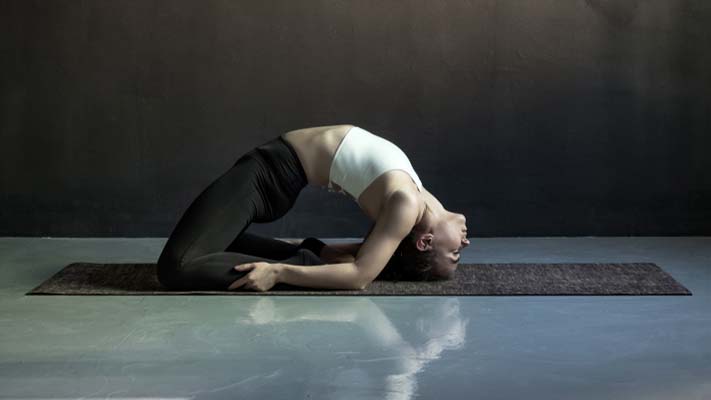Kapotasana Yoga: Opening the Heart and Expanding Consciousness with Pigeon Pose
Table of Contents
Introduction
Kapotasana Yoga, or Pigeon Pose, is a deep and transformative yoga posture that symbolizes grace, surrender, and opening of the heart. Derived from the Sanskrit words “kapota” (meaning pigeon) and “asana” (meaning pose), Kapotasana invites practitioners to cultivate physical and emotional flexibility, while simultaneously connecting to their inner strength and wisdom.
In this article, we will explore the steps, benefits, variations, and precautions associated with Kapotasana, empowering you to incorporate this heart-opening pose into your yoga practice.
How to Perform Kapotasana Yoga
To practice Kapotasana Yoga, follow these step-by-step instructions:
Step 1: Begin in a tabletop position with your hands and knees on the mat.
Step 2: Slide your right knee forward, placing it behind your right wrist. Your right foot should be near your left hip, with the toes pointing diagonally back.
Step 3: Extend your left leg straight back, keeping the top of your foot on the mat.
Step 4: Square your hips as much as possible, ensuring that your right hip is aligned with your left hip.
Step 5: Inhale and lengthen your spine, lifting your chest and rolling your shoulders back.
Step 6: As you exhale, slowly walk your hands forward, lowering your torso toward the mat.
Step 7: Rest your forearms on the mat, extending them forward, or place your palms flat on the mat in front of you.
Step 8: Find a comfortable position for your head and neck, either resting your forehead on your forearms or using a block for support.
Step 9: Hold the pose for 5-10 deep breaths, allowing your body to relax and surrender into the posture.
Step 10: Repeat on the opposite side by switching the placement of your legs.
Benefits of Kapotasana Yoga
Regular practice of Kapotasana Yoga offers a wide range of physical, emotional, and energetic benefits, including:
a. Hip Opening and Flexibility: Pigeon Pose deeply stretches the hip flexors, glutes, and piriformis muscles, improving hip mobility and releasing tension in the hips.
b. Heart Opening and Emotional Release: Kapotasana creates space in the chest and shoulders, helping to release stored emotions and cultivate a sense of vulnerability, compassion, and self-acceptance.
c. Improved Posture and Spinal Alignment: By stretching the muscles of the back and shoulders, Pigeon Pose promotes proper spinal alignment, helping to alleviate back pain and improve overall posture.
d. Deep Relaxation and Stress Relief: The elongated, supported position in Kapotasana encourages relaxation, activates the parasympathetic nervous system, and promotes a state of calm and inner peace.
e. Energy and Chakra Activation: The opening of the chest in this pose stimulates the heart chakra, fostering the flow of love, compassion, and positive energy throughout the body.
f. Digestive Health and Detoxification: The compression of the abdominal organs in Kapotasana massages the digestive system, improving digestion, and supporting detoxification processes.

Variations of Kapotasana Yoga
Explore these variations of Kapotasana Yoga to modify the pose according to your level of practice and flexibility:
a. Supported Kapotasana: If you find it challenging to fully lower your torso to the mat, place a bolster, block, or folded blanket under your forearms or forehead for support.
b. One-Legged King Pigeon Pose: To deepen the hip stretch, you can fold your back leg, reaching back with your hand to grasp the foot and bring it closer to your head. This variation requires additional flexibility and should be practiced with caution.
c. Supine Pigeon Pose: For individuals with knee or hip sensitivities, you can lie on your back and cross one ankle over the opposite thigh, gently pressing the knee away from the body. This reclined variation provides a similar hip-opening effect without putting weight on the knees.
Precautions and Contraindications
While Kapotasana Yoga offers many benefits, it’s important to consider the following precautions:
a. Avoid practicing Kapotasana if you have any recent or chronic knee, hip, or back injuries. If you have concerns or limitations, consult with a healthcare professional or an experienced yoga instructor before attempting this pose.
b. Pregnant women and individuals with high or low blood pressure, herniated discs, or sciatica should approach this pose with caution or avoid it altogether.
c. Always listen to your body and work within a comfortable range of motion. Do not force yourself into the pose or exceed your limits.
Conclusion
Kapotasana Yoga, the Pigeon Pose, invites you to embrace vulnerability, open your heart, and cultivate flexibility both physically and emotionally. As you practice this transformative pose, Kapotasana offers a myriad of benefits, including hip opening, emotional release, improved posture, relaxation, and energy activation.
Approach this pose with patience, respect for your body’s limits, and a gentle sense of exploration. Incorporate Kapotasana into your yoga practice to experience the profound expansion of the heart, enhanced flexibility, and a deep sense of inner connection and harmony.





